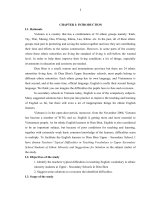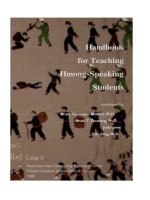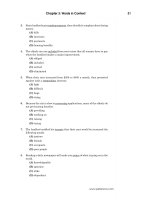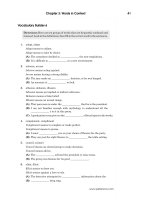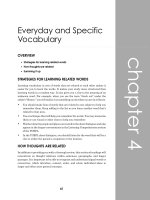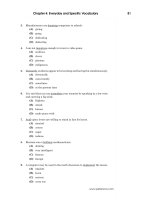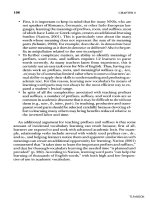Teaching Vocabulary pptx
Bạn đang xem bản rút gọn của tài liệu. Xem và tải ngay bản đầy đủ của tài liệu tại đây (1.41 MB, 32 trang )
Teaching Vocabulary
What to Teach About an Item
Techniques for Eliciting New Vocabulary
Steps for Presenting Vocabulary
Techniques for Checking Vocabulary
What to Teach About an Item
What the word means
Its form/part of speech (e.g. noun, adj…)
How it is pronounced
How it is spelt (written form)
If it follows any unpredictable
grammatical patterns (e.g. effect on, fight
against)
The connotations (associations, positive or
negative feelings) the item may have (e.g.
DOG (friendship, loyalty, dirt & inferiority)
What to Teach About an Item (con.)
The situations when it is (not) used (Is it
formal/neutral/informal?- in speech or in
writing? Is it outdated? Wireless instead
of radio)
How it is related to others (syno., anto…)
Collocations (ways words occur together-
e.g. raise your hands not lift your hands)
The prefixes & suffixes may indicate the
meaning
Techniques for Eliciting
New Vocabulary
1. Visuals
2. Mime
3. Realia
4. Situation/Explanation
5. Example
6. Synonym/Antonym
7. Translation
1. Visuals
Example 1: PLOUGH
Example (2): PLOUGH
Example (3): a plot of land
Example (4): HARROW
2. Mime
Example (1): to pump
T: miming pumping a balloon
T asks, “What am I doing?”
Example (2): transplanting
T: miming transplanting young rice plants
T asks, “What am I doing?”
These peasants are transplanting
young rice plants
3. Realia
Example: mouse
T. Brings a real (computer) mouse into
class.
T. asks, “What’s this?”
Example: off (adv), on (adv)
T. turns off/on the laptop.
T says, “Tell me about the laptop. It’s…
What?”
4. Situation/Explanation
Example: go off (U1)
T. explains, “getting up early is the
most difficult thing, and I usually set
up my alarm before going to bed, so
it can wake me up at 5:00.”
T asks, “what does the alarm do at
5:00?”
Tell me the word in Vietnamese. Now
listen to it in English “go off”
4. Situation/Explanation (con.)
Example: crop
T. says, “the amount of rice, fruits that the
peasants harvest in this season is higher
than that of the previous season.”
T asks,” what do the peasants have? They
have a good……(Tell me the word in
Vietnamese) Now listen to it in English
“crop”
5. Example
Example (1): plan(s)
T. lists examples of her plan for next year:
“buying a car, having a baby, building a
new house…Give me an example of ……
your (plan) ”
Example (2): (to) chat
T. says, “I have a close friend living in the
United States, so every evening I can
talk heart to heart with her online.”
T. asks, “How can I contact my friend
every day?”
6. Synonym/Antonym
Example (1): contented with
T. asks, “what is another word for contented
with?”
Example (2): fellow
T. asks, “What is the opposite of fellow?”
7. Translation
Example (1): bank (n)
T asks, “How do you say ‘bờ sông or bờ ruộng’
in English? Listen to it in English ’BANK’ “
Example (2): peasant (n)
T asks, “ How do you say ‘nông dân’ in
English?……Listen to it in English ’peasant’
“
Steps for Presenting Vocabulary
Eliciting & Illustrating the meaning of the
new word (by using # techniques)
Modeling/Presenting the item
(written/spoken)
Letting Ss repeat chorally
Asking some Ss to repeat it
Correcting pronunciation (if happening)
Checking L1’s equivalent
Checking pronunciation (stress pattern)
Checking spelling
Techniques for Checking Vocabulary
1. Bingo!
2. Guess the
picture
3. Jumbled words
4. Matching
5. Networks
6. Noughts &
Crosses
7. Ordering
8. Rub out &
remember
9. Slap the board
10. Where & What
11. Word square
12. Wordstorm
1. Bingo!
Aim: to get Ss to practice listening to new words &
match sounds with spelling
Getting Ss to brainstorm a list of 10-15 new
words & putting them on the board
Ss choose 5 words to copy them in their books
Reading out the words in any order
Each time the student has one of the words the
teacher reads, s/he puts a tick next to that
word.
The first student to tick all five words shouts
“Bingo!”
2. Guess the picture
Aim: to get a lot of Ss to practice saying the new words in
a meaningful way
Make A4 pictures of new words you are going to teach
Put the pictures in a file
Get Ss to come to the front & choose one of the
pictures
Make sure nobody else can see which picture has been
chosen
Get the rest of the class to guess which picture it is
Ss ask, “Is it a…?”
The 1
st
student to guess the picture correctly comes
up to the front, chooses a new picture & the game
continues.
3. Jumbled words
Aim: to get Ss to practice spelling new words
The teacher writes 5 or 6 words with jumbled letters
on the board & tell Ss what the topic is.
Ss write the words correctly in their books
Ss come to the board to write the correct words there
to see if everyone agrees.
Example: Topic SCHOOL SUBJECTS
HSICPSY= THAMS=
LYGIOBO= TYHOSIY=
RUTELARITE=
4. Matching
Aim: To get Ss to match the new vocabulary with
definitions, translations of pictures. To save time pre-
teaching
Write the new words in a list on the left side on the
board
Write definitions, translations or draw pictures, on
the right side of the board
Get Ss to come up the board & match items in the left
side list with item in the right side list by drawing a
line between them
4 or 5 Ss can work at the board at the same time
Check answers by asking the class, “Do you agree?”
5.Networks
Aim: to get Ss to revise lexical sets; to put
words from different lessons into one
context so Ss remember them better
Write the network like in the example on the
board and put some more words below it.
Don’t use just concrete nouns-remember to
include some verbs
Get the Ss to put the given words in the
appropriate circles
Ss fill in the remaining empty circles with
their own words.
6. Noughts & Crosses
Aim: to get Ss to put new vocabulary in a sentence
The teacher puts a grid on the board with 9 words in
it.
Ss work in pairs. ONE of the Ss copies the grid in
his/her book.
One student is “noughts” (‘O’), and the other is
‘crosses’ (‘X’)
One student starts. S/he chooses a word & makes a
sentence with it. If the sentence is correct, s/he puts
her mark (“O” or “X”) in that square.
The 1
st
student to get three-in-a –row (across, down
or diagonally) wins.

